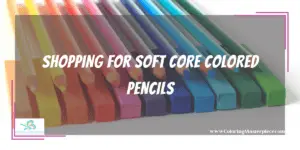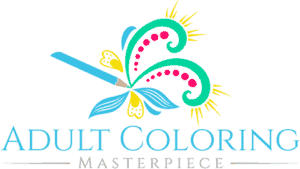A soft-core colored pencil is the perfect tool for blending, shading, and coloring in those delightful coloring books for adults.
Softcore colored pencils have a soft coloring center surrounded by a wood casing. The casing makes using them just like using an ordinary number two pencil or a regular drawing pencil. The centers are a soft, color-saturated combination of graphite, clay, and binders. They are excellent for projects that need graduated colors and blended edges.
Distinguishing Characteristics of Modern Colored Pencils

Colored pencils today are not the same as the pencils that were used to make those fading art projects created by your parents or grandparents. Modern technology has brought us a wide variety of colored pencils, including soft core colored pencils, that have moved them from an art tool primarily used for school map projects to being a versatile, modern art medium that is delightfully easy to use.
Types of Soft Core Colored Pencils
There are three main types of soft-core colored pencils: wax, graphite, and oil. Sometimes these are blended to lend smoothness and permanency to the color. Soft-core pencils are distinguished from hard-core colored pencils by their smoothness and their ability to blend.
Uses of Colored Pencils
Colored pencils are an excellent choice for projects such as color charts, pictures that include folds of cloth, subtle shading on leaves, and much, much more. They can be used for pointillism, but need a light hand to avoid breaking the point. Because their points will wear down quickly, and because they can be somewhat difficult to sharpen, they are less useful for hatching, cross-hatching, or outlining.
One way to get around the breaking point and to help cover large areas of color is to use the side of the exposed core rather than the tip. To do this, position the pencil across the palm of your hand, curling the thumb and third, fourth, and pinkie fingers to hold it in place while bracing the pencil and color core with the index finger. (This is a technique often used when shading with drawing pencils.) This allows a broader area of the color core to make contact with the paper. At the same time, using the pencil will help restore the point without shaving away the precious pigment.
Grades and composition of Colored Pencils
The wax and graphite pencils are the least expensive but can come in various grades. For example, student or budding artist pencils tend to be less expensive, but not as creamy or blendable as professional-grade pencils. Wax-based pencils are easy to use, and can often be applied to full color with one layer. However, unless a fixative is applied, they tend to develop what is known as “wax bloom” in which the wax rises to the surface of the picture and the colors begin to fade.
Soft Core oil colored pencils, sometimes known simply as oil pencils, have a small amount of wax but depend much more on an oil binder to hold the pigment together. Even at the professional level, oil pencils tend to be more expensive than graphite and wax pencils. They are also a little harder than wax or graphite pencils and might require layering on the color to achieve the desired hue.
Check out five ways to soften colored pencils HERE!
On the flip side of that, oil pencils are easy to blend and take readily to the use of blending pencils, overlays of lighter colors, and even lightly liquid mediums for certain special effects. They are not as susceptible to wax bloom (since very little wax is used in their composition) and tend to retain their bright colors over time. With that said, they might need a curing time to prevent smearing, and if stored in a sketchbook or album, need a waxed paper protector to prevent imprinting on the opposite page.
Blending Agents and Fixative
Blending agents allow advanced coloring techniques. A clear or colorless blending pencil can be rubbed over the applied color to soften edges and mix colors. Light color or white pencil can be used to add highlights or create pastel effects.
Fixative, often available as a spray, is a substance applied to the picture after it has been completed. This will help reduce color fade when using wax-based pencils and help prevent oil-based pencils from smearing.
Shopping for Soft Core Colored Pencils

When shopping for colored pencils, you might wonder what the difference is between the store brand, the intermediate brands, and the expensive brands labeled “professional.” The answer is, of course, quality.
Things to look for in a good, soft-core colored pencil:
- Goes on smoothly
- Blends easily
- Can be layered
- Easy to sharpen
- Will retain color over time
Goes on Smoothly
Although papers and other surfaces will make a difference in the way a pencil’s color will adhere to the surface, the color should spread without effort on even the lightest papers. A pencil that has been sharpened to an extreme point might tear a light paper, especially if used for hatching or outlining. One that applies smoothly is less likely to disturb the grain of the paper or tear through it.
Blends easily
Few things in the natural world come with hard lines around them. This especially applies to people’s faces, animals’ coats, or even a blade of grass. However, when drawing, one often starts with an outline. The ability to blend color softens these lines and also allows for the easy creation of highlights and shadows.
Can be layered
Layering can be applied to several art techniques. One is a method that allows the application of a contrasting color over a base color, followed by judiciously scraping off some of the top colors. Another technique is to use hatching or cross-hatching with different colors to allow the eye to blend the colors. Yet another is to rub two colors that have been applied one over the top of the other to mix the pigments.
Can be sharpened
Although colored pencils should not be sharpened with a mechanical or powered pencil sharpener, they can usually be sharpened with a hand sharpener, especially one made for colored pencils. Softcore pencils are more of a challenge than ordinary colored pencils because the core is, well, soft. With that said a good-quality pencil should take a reasonable point without the core crumbling or breaking in half. By the same token, the wooden case should easily sharpen away without splintering or breaking.
Retains color over time
As mentioned, wax-based pencils tend to develop wax bloom, which dims the colors. Oil-based soft-core pencils are less subject to wax bloom (since they have relatively small amounts of wax included.
Some Brands of Colored Pencil
Prismacolor
It is an excellent mid-range colored pencil that comes with the grades, hardness, and purpose clearly labeled.
Faber-Castell
It makes professional-grade art supplies of all sorts, including oil-based colored pencils that are superb. (And that has a matching cost.) If you are doing professional artwork, this is an excellent supply source.
Crayola
Crayola brand is a good source for school-supply crayons or that traveling art kit in which you do not want to include your best gear. They will deliver a reasonable coloring grade for sketches and other temporary work.
Store Brand
While there are some good store brands of art supplies, these are usually colored pencils that the other brands find unacceptable. Reserve for when you need something quick and are not feeling too particular about quality.
Frequently Asked Questions
What surfaces are good for colored pencils?
Colored pencils can be used on almost any kind of art or coloring book paper. They can also be applied to Masonite, wood, vellum, or Plexiglas.
What are some good art projects on which to use colored pencils?
Portraits, landscapes, mandalas, coloring book pages, color-by-number, and maps. They are also good for color-underlining documents or textbooks since they do not bleed through like markers or gel pens.
How can I blend colors using soft-core colored pencils?
You can blend colors using soft core colored pencils by hatching (placing lines of color side by side), cross-hatching (placing lines side by side then placing another set of lines across the top of the first set in a different direction), or by using pointillism (placing dots of color), or by putting down a layer of one color, then a layer of another color, and then gently rubbing the colors to mix them.
How would I use color layering to create a portrait using soft-core colored pencils?
A good use of layering when creating a portrait would be to first lightly color in the base skin tone of the person. Next, color over the base color with a slightly darker shade to create shadows in areas such as beneath the cheekbones, under the chin, or beside the nose. Lightly use contour lines or cross-hatching to create rounding, and then lightly add in some highlights using colors that go well with the base color. Gently rub the colors to blend them.
Maximize the benefits of coloring with my free adult coloring eBook and by signing up for my email newsletter HERE!
Disclaimer: The information provided by ColoringMasterpiece.com (“The Site”) is for general informational purposes only. All information on the Site is provided in good faith, however, we make no representation or warranty of any kind, express or implied, regarding the accuracy, adequacy, validity, reliability, availability, or completeness of any information on the Site. Under no circumstance shall we have any liability to you for any loss or damage of any kind incurred as a result of the use of the Site or Reliance on any information provided on the Site. Your use of the Site and your reliance on any information on the Site is solely at your own risk. This blog post is for educational purposes only and does not constitute legal advice. Please consult a legal expert to address your specific needs.
Terms and Conditions: https://coloringmasterpiece.com/terms-and-conditions/
